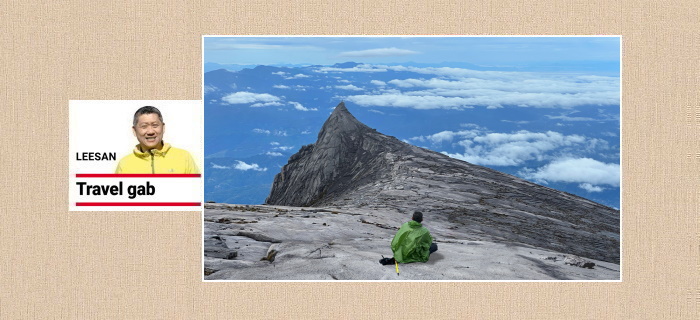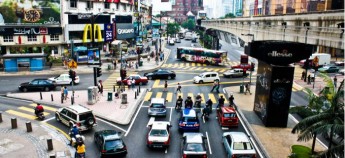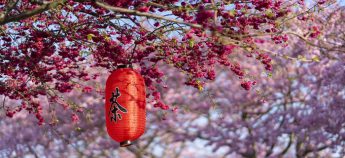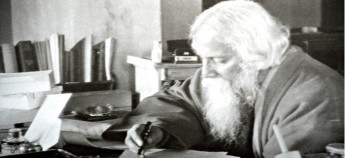Conquering Mount Kinabalu – by leesan
Our intrepid columnist heads to Sabah to climb the nation’s highest peak.
PRIOR to the pandemic, an average of 60,000 people climbed the 29th highest mountain in SouthEast Asia – the 4,095m high Mount Kinabalu in Sabah – every year. However, after Covid-19 happened, only a maximum of 163 people are allowed to climb the mountain by the Kinabalu Park authorities each day, during climbing season.
Conquering Mount Kinabalu is not an impossible or even inaccessible dream. It is said that the oldest climber who has made it to the summit is a 96-year-old Japanese woman (according to a report in 2006), followed by a 90-year-old Sabahan man named Buatin Blandong, who made his climb last year. This shows that as long as you have the courage and determination (plus strong legs, of course!), and do not suffer from any major cardiorespiratory problems, you too can make it to the top.
The first stage of the climb is about 6km, with an altitude of 1,866m to 3,273m above sea level. A physically robust climber should be able to do the climb in three to four hours, while an average climber would take five to six hours. For the less physically fit, a seven to eight-hour trek is the norm.
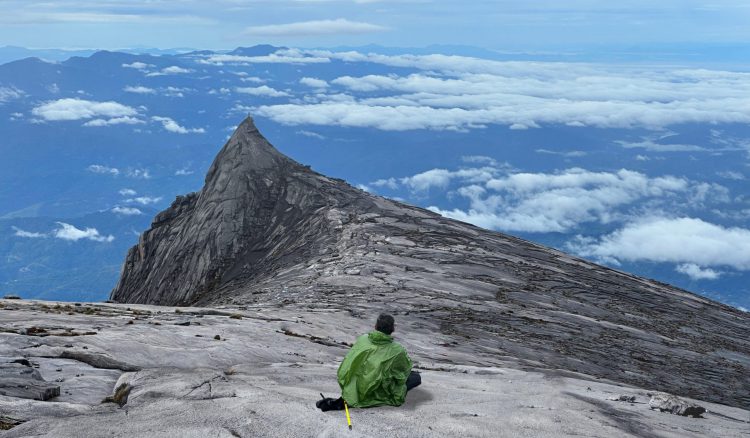
The columnist enjoying a good view of the peak, the same one that appears on our RM100 banknote. — Photos: Leesan
Day 1: Downpour
It took me six hours and eight minutes to complete the first 6km stretch. This included a 20-minute break for lunch. If you are someone who hates climbing up stairs then this probably won’t be an enjoyable experience for you. The biggest obstacle in scaling Mount Kinabalu is not how tough or how steep the path is, but whether you can be sure you won’t suffer a muscle cramp.
We kicked off our climb from Timpohon, which is 1,866m above sea level, and right from the start the trail was rather steep, interspersed with both wooden and cement steps. There was not a stretch of flat ground for us to walk on at all. It seemed like Mount Kinabalu was greeting its challengers with tough hurdles from the very beginning, and it was difficult to assess just how torturous the journey ahead was going to be.
I started to experience a sharp muscle cramp at the 3.5km mark. My Dusun guide Gasbriel, who has 15 years of Mount Kinabalu climbing and guiding experience, taught me how to alleviate the pain or at least, prevent it from getting worse. He told me to just keep on walking, but to simultaneously adjust the tone of my muscles.
We finally arrived at a small hut at the 4km mark, where we got to rest for a bit. It took us about four hours to get there, which is an average progress of 1km per hour.
Gasbriel said I was awesome, so that perked me up a little. However, the next 2km was a whole lot more challenging, and the heavy rain certainly did not make things easier for anyone. I could faintly hear a female climber from China mumbling to herself: “I can’t catch a cold. No, I can’t catch a cold!”
We struggled to make our way to the next stop. The good thing was that my legs were feeling better by then, and I opted to slow down my pace too, inching my way forward instead of taking long strides.
Along the way, I could still appreciate the rustic beauty of the virgin forest despite being tired. It is said that there are five to six thousand plant species thriving in the park, and I was lucky enough to catch a glimpse of an exquisite pitcher.
Actually, this stretch of the path is even steeper and more strenuous. As a result, we had to stop every 200m to take a breather and to keep my body functioning optimally. I was thinking that those physically robust and nimble warriors could have already reached Panalaban, our destination for the day, by now.
In the 30th Mount Kinabalu International Climbathon in 2017, Sabahan Safrey took only two hours and 18 minutes to reach the Panalaban Base Camp. The record is still maintained to this day.
As for me, I was still at the 5km mark at an altitude of 3,000m above sea level after five whole hours of sluggish progress. Here, the oxygen saturation is merely 70%, and you might experience slight difficulty in breathing, but that probably will not be an issue for many people.
Even though I was fully draped in waterproof gear, due to the heavy downpour my whole body was completely drenched. And to make things worse, the outdoor temperature was a chilly 15°C. Nevertheless, when the guide told me that we only had 500m to go, I instantly recouped my energy and power.
At 3.20pm, we finally reached the Panalaban Base Camp at 3,273m. In the lobby, I ordered a hot cup of Milo that cost me RM15 but it was totally satisfying in the cold weather. Unfortunately, there was no hot shower facility at the base camp hostel.
Dinner was from 4.30pm to 6pm and the buffet consisted of a sumptuous spread of delicious treats.
At 7.30m it was lights off for everyone – time to sleep! There was no heater at the hostel, but the blankets were thick enough to keep us warm and cosy. I nevertheless found it difficult to actually get any sleep much of the night. Could it be the altitude?

Conquered the 4095.2m, feeling good!

If you think the climb up is difficult, wait till you have to descend!
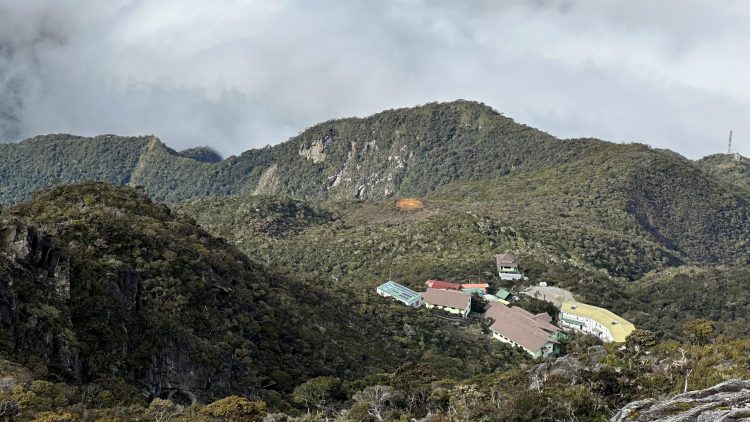
A view of the Panalaban Base Camp from the peak.
Day 2: Foggy
We woke up at 1.30am, had some light breakfast and waited for the gate to open at 2.30am sharp. Outside, it was completely dark but the seasoned climbers told us to turn on our headlamps and slowly make our way forward, following the other climbers. The team set off in high spirits towards the summit.
We started from the 6km mark at 3,290m, but when we reached the 6.7km mark, the steps were almost vertical. Luckily, there was a handrail to help us make our way to the checkpoint. My guide had reminded me earlier that the next 800m was going to be the toughest throughout the whole journey, and that the downhill descent could be even more demanding.
For the next 2km, we had to make our way along the steep cliffside trail, clinging tightly onto the white rope as we ascended with all our might.
While we were doing this, the woman next to me said she felt dizzy, and then started vomiting. I guess she was suffering from altitude sickness.
I actually like this specific part of the climb, with the bright moon hanging high above us and the crisp frosty wind kissing our cheeks. What a delightful experience.
The sky slowly brightened up and I thought I could faintly see that protrusive peak featured on our RM100 note in front of us.
Everyone was so excited by the sight, and seemed to forget about the physical fatigue and all the hardships we had gone through.
Weirdly, my legs seemed to feel completely fine, too!
During the final 500m, it started to drizzle and it became pretty foggy. It looked like we weren’t getting a good view of the sunrise, but that’s okay.
We saw some foreigners coming down from the summit by then, but I still had another hour or so to go before getting to the summit. You can definitely see the difference between the strong and the not so strong.
At 6.30am, we were finally standing at Low’s Peak at 4,095m (4,095.2m to be exact).
Hurray! I finally conquered the mighty Mount Kinabalu!
Mount Kinabalu is the highest point in Malaysia and I do believe that if even an old man my age could make it to the top, so can you.
Day 2: Descent In 1851 during the colonial times, the then British administrator and naturalist Hugh Low became the first Westerner to have conquered Mount Kinabalu and discovered its jutting rock formation. The summit was named after him.
But let’s get back to the climb, or rather, the descent. To a physically fit person, the downhill journey could be completed at lightning speed, but to the majority of climbers going down from Mount Kinabalu, the descent could be a stringent test of the fitness of the climber’s knees, ankles and leg muscles.
The rocks, the wooden stairs and ropes along the way are all very slippery and could prove to be very challenging to handle. It took us two hours to get down a total of 2.8km.
Going down the same way we came, meaning the steep upward path we came in the beginning, was now an almost vertical ownslope. Our guide suggested that we moved step-by-step horizontally downward to make sure we don’t hurt our joints.
However, this method took us a longer time to get down.For the final 6km descent, we spent five hours and 30 minutes to complete. Not too bad!
When we ascended on the first day, we saw a climber being carried down in a stretcher by four mountain guides, while two others were carried on their guides’ backs.
Still, I have nothing but respect for each and every one who choose to boldly take the first step into doing something “impossible” or difficult, because I believe that “doubt sees theobstacles; faith sees the way”.
Leesan, the globe-trotting traveller who has visited 137 countries and seven continents, enjoys sharing his travel stories and insights. He has also authored five books.

Published in STAR 2, 12 Aug 2023
全球超过80000家酒店,Apple101助您轻松订房,出行无忧,绝对优惠价。入住期间付款,多数客房可免费取消!
